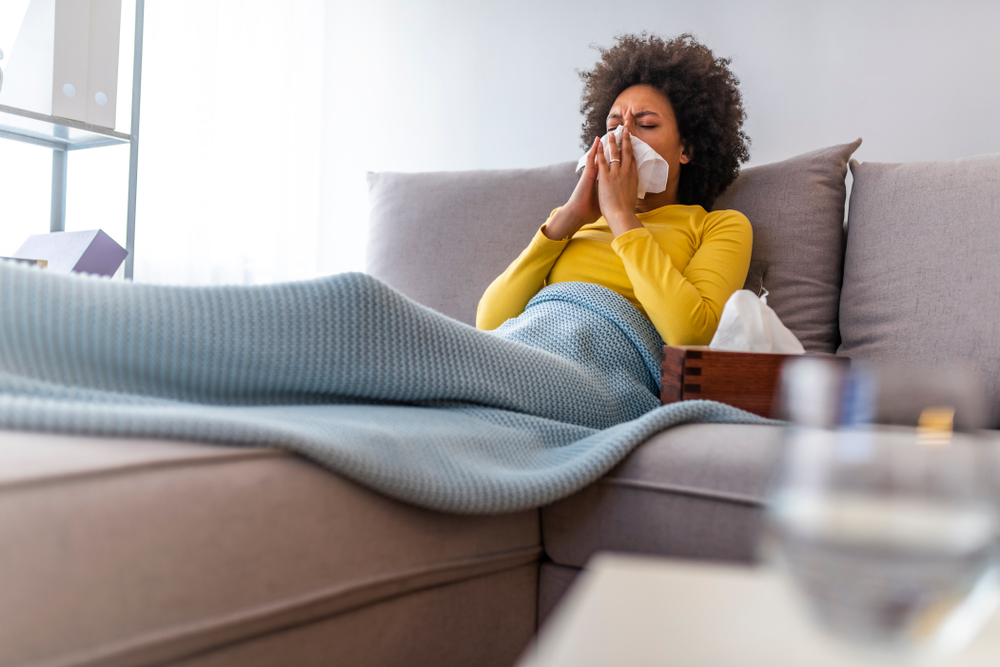That annoying sniffle started yesterday, and now your throat feels scratchy. A few years ago, you wouldn’t have thought twice before dismissing it as just another cold. But in our post-pandemic world, even the mildest symptoms can trigger a wave of worry. Is it just a harmless cold, or could it be COVID-19?
It’s a question that’s become part of our everyday reality, and for good reason. While both illnesses share some overlapping symptoms, their potential impacts on our health differ significantly. Understanding what sets these two viral troublemakers apart could make all the difference in how quickly you recover and whether you inadvertently spread something serious to the people around you.
The sneaky viruses behind your symptoms
When it comes to the common cold, you’re dealing with a rotating cast of viral villains. Over 200 different viruses can cause those familiar cold symptoms, with rhinoviruses leading the pack as the most frequent offenders. These cold-causing viruses have been around for centuries, co-evolving with humans and generally causing mild, if annoying, infections.
COVID-19, on the other hand, comes from a single culprit – the SARS-CoV-2 virus. This relative newcomer to the human viral landscape emerged in late 2019 and quickly revealed its ability to cause a much wider range of health effects than typical respiratory viruses. While it certainly can cause cold-like symptoms, its impact can extend well beyond your nose and throat.
This fundamental difference in viral behavior explains why COVID-19 requires more caution. Cold viruses have settled into a relatively predictable pattern of causing upper respiratory symptoms, while SARS-CoV-2 has demonstrated its ability to affect multiple body systems, from your brain to your toes.
Timing matters when symptoms first appear
One helpful clue in distinguishing between these infections is how quickly symptoms develop after exposure. With a common cold, you’ll typically start feeling those first sniffles or throat tickles within one to three days after being exposed to the virus. The progression is usually gradual – perhaps starting with a sore throat that develops into congestion and then a cough.
COVID-19 operates on a different timeline. Symptoms can take anywhere from two to 14 days to appear after exposure, with most people developing symptoms around day five. This longer incubation period is one reason COVID-19 spread so effectively – people can be contagious before they even realize they’re sick.
This timing difference isn’t foolproof for diagnosis, but it can provide helpful context. If you know you were exposed to someone with a respiratory illness just yesterday and you’re already developing symptoms today, a cold might be more likely than COVID-19.
The symptom overlap that causes confusion
Both illnesses can bring on a constellation of miserable symptoms – which is precisely why telling them apart can be so challenging without testing. The common symptoms shared by both conditions include fever, cough, fatigue, sore throat, headaches, and body aches. Either infection can make you feel pretty lousy for a few days.
But certain symptoms are more strongly associated with COVID-19 than with a typical cold. Loss of taste or smell became one of the pandemic’s most recognized symptoms, though less common with newer variants. While a cold might dull your senses slightly due to congestion, COVID-19 can cause a more profound loss of these senses, even without a stuffy nose.
Shortness of breath is another red flag that suggests COVID-19 rather than a cold. While severe colds can sometimes cause breathing difficulty, especially in people with asthma or other respiratory conditions, significant breathlessness is much more characteristic of COVID-19 and warrants immediate medical attention.
The overall pattern of symptoms can provide clues too. Colds typically focus on the head and neck – think sneezing, runny nose, and sore throat. COVID-19 often brings more whole-body symptoms like fever, extreme fatigue, and muscle aches, along with respiratory symptoms that can progress to the lower respiratory tract.
How these viruses jump from person to person
Both the common cold and COVID-19 spread through respiratory droplets expelled when an infected person coughs, sneezes, speaks, or even breathes. These droplets can land in the mouths or noses of people nearby or possibly be inhaled into the lungs. This similar transmission route contributes to the confusion between the two illnesses.
However, COVID-19 has a transmission superpower that most cold viruses lack – it can also spread through smaller particles called aerosols that can linger in the air for hours, especially in poorly ventilated spaces. This airborne transmission capability makes COVID-19 significantly more contagious than the common cold and explains why it can spread so efficiently in indoor settings even when people maintain some distance from each other.
Another crucial difference is when people are most contagious. With colds, people are typically most contagious during the first three days of symptoms, when they’re sneezing and have a runny nose. With COVID-19, people can spread the virus before they ever develop symptoms, during the days they feel fine but the virus is silently replicating in their body. This pre-symptomatic spread has been one of the most challenging aspects of controlling the pandemic.
The typical recovery timeline you can expect
For most healthy adults, a common cold runs its course in about a week. You might feel worst around days three or four, with symptoms gradually improving after that. Some symptoms, particularly a cough, might linger for up to two weeks, but most people return to normal activities within 7-10 days. Children, older adults, and people with respiratory conditions might take slightly longer to fully recover.
COVID-19 follows a less predictable pattern. Mild cases might resolve within a similar timeframe to colds – about one to two weeks. However, moderate to severe cases can take considerably longer, with some people requiring weeks or even months to fully recover.
Perhaps the most significant difference in recovery is the phenomenon of Long COVID, where symptoms persist for months after the initial infection. These lingering effects can include profound fatigue, cognitive difficulties often described as “brain fog,” heart palpitations, shortness of breath, and joint pain. Nothing comparable typically follows a common cold, which rarely leaves any lasting effects once the infection clears.
Your body’s defense system responds differently
Your immune system reacts to these viral invaders in subtly different ways. With the common cold, your body mounts a targeted response that’s usually quite effective at clearing the infection. You feel crummy for a few days while your immune cells do their work, but the battle stays primarily in your upper respiratory tract.
COVID-19 can trigger a more complex immune response. In most cases, your immune system handles the infection effectively, similar to how it fights a cold. But in some people, particularly those with risk factors like older age or certain health conditions, the immune response can become dysregulated.
This overactive immune response, sometimes called a “cytokine storm,” can cause widespread inflammation throughout the body, damaging not just the lungs but potentially also the heart, kidneys, and other organs. This explains why COVID-19 sometimes causes severe illness requiring hospitalization, while colds rarely lead to serious complications in otherwise healthy individuals.
Treating symptoms to feel better faster
Since both illnesses are caused by viruses, antibiotics won’t help either one. Treatment for both conditions focuses on relieving symptoms while your immune system does the heavy lifting of clearing the infection.
For a common cold, the tried-and-true remedies your grandmother recommended still apply. Rest and plenty of fluids help support your immune system. Over-the-counter medications like acetaminophen or ibuprofen can reduce fever and ease aches and pains. Decongestants might help unstuff your nose, while cough suppressants can quiet a nagging cough enough to let you sleep.
Mild COVID-19 cases can be managed with similar supportive care at home. However, people at higher risk for severe illness may benefit from prescription antiviral medications that can help prevent the infection from progressing. These medications work best when started early in the course of illness, which is why prompt testing and medical consultation are important if you have symptoms and risk factors.
For more severe COVID-19 cases, hospitalization might be necessary to provide oxygen support, monitor vital signs, and administer more intensive treatments. This level of medical intervention is rarely needed for the common cold.
Prevention strategies that work for both
Many of the same preventive measures work against both the common cold and COVID-19, though they’re even more important for the latter given its potential severity.
Frequent hand washing remains one of the simplest and most effective ways to reduce your risk of both infections. Cold viruses often transfer from surfaces to your hands and then to your face, while COVID-19 spreads this way less frequently but still possibly.
Avoiding close contact with sick people helps prevent both illnesses. Since people can spread COVID-19 before showing symptoms, maintaining some distance from others, especially in indoor public settings during periods of high transmission, provides additional protection.
Masking in crowded indoor settings can reduce the risk of both infections, though it’s particularly valuable for preventing COVID-19 due to its airborne transmission capability. High-quality masks like N95s or KN95s offer the best protection when worn correctly.
Vaccination represents a significant divergence in prevention strategies. While no vaccine exists for the common cold due to the many viruses that cause it, COVID-19 vaccines have proven highly effective at preventing severe illness, hospitalization, and death, even as the virus has evolved.
The testing options that provide clarity
One of the most reliable ways to distinguish between a cold and COVID-19 is through testing. If you’re experiencing symptoms and aren’t sure which virus is responsible, testing can provide valuable clarity.
Rapid antigen tests for COVID-19 are widely available for home use, providing results in about 15 minutes. While not as sensitive as PCR tests, especially early in infection, they can detect COVID-19 when viral loads are high. Some healthcare providers recommend testing multiple times over several days for the most reliable results, as viral levels change throughout the course of infection.
PCR tests, usually performed at healthcare facilities or testing centers, remain the gold standard for COVID-19 detection. These highly sensitive tests can detect the virus earlier in the course of infection.
No widely available home tests exist for diagnosing the specific viruses that cause the common cold. Healthcare providers can test for these viruses when necessary, but such testing is usually reserved for vulnerable populations or unusual situations.
The availability of COVID-19 testing represents a significant advancement in our ability to differentiate between these similar respiratory infections and take appropriate actions to protect ourselves and others.
When symptoms demand medical attention
While both infections typically resolve without medical intervention, certain warning signs indicate the need for prompt medical care.
For either illness, difficulty breathing, persistent chest pain or pressure, confusion, inability to stay awake, or bluish lips or face require emergency medical attention. These symptoms suggest severe illness that needs immediate treatment.
With COVID-19, pay particular attention to oxygen levels if you have access to a pulse oximeter. Oxygen saturation consistently below 94% warrants medical evaluation. Some people with COVID-19 experience “silent hypoxia,” where oxygen levels drop dangerously low without causing noticeable shortness of breath.
For both conditions, symptoms that worsen after initially improving merit medical attention, as this pattern can indicate a secondary bacterial infection that might require antibiotics. Symptoms persisting beyond 10 days without improvement also suggest you should consult a healthcare provider.
Children with either infection should be closely monitored for warning signs like rapid or difficult breathing, dehydration, extreme irritability, or lethargy. Older adults and people with underlying health conditions should have a lower threshold for seeking medical care, as they’re more vulnerable to complications from both viruses.
Understanding these distinctions between the common cold and COVID-19 empowers you to make informed decisions about when to test, when to isolate, and when to seek medical care. While the symptoms may sometimes look similar, recognizing the important differences can help protect your health and the health of those around you during respiratory virus season.















